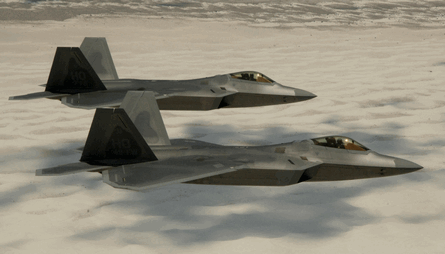President Barack Obama inherits what is by any measure a financially prosperous and sound US aerospace industry - and one of the few sectors of the economy not facing crisis or already collapsed.
However, with an annual budget for researching, developing and producing weapons topping $175 billion, the Obama administration also inherits complications.
One of those problems is not a shortage of money by historical terms. The budget for the Department of Defense is higher now in absolute terms than any time since the end of the Second World War. Ironically, some in the industry say this fact combined with the sector's relative health in a financial target could be a toxic combination.
The reality of the situation is more complex. Obama's decision on military spending may ultimately depend on unforeseen events, such as wars or terrorist attacks, that may occur in his administration, but the long-term trends in military spending are otherwise clear.
Government projections for the DoD's rate of spending appear remarkably stable for the foreseeable future, but this implies steep declines for weapons procurement relative to the overall economy.
CONSECUTIVE RISES
Excluding a yet-undefined war supplemental, Congress allocated $517 billion to the DoD in fiscal year 2009, sustaining an 11-year streak of consecutive annual budget increases.
 |
|---|
© USAF |
In the USA, spending on defence has historically operated in roughly 10- to 15-year cycles of boom and bust, with the most recent downturn ending in 1997. The near-term outlook shows that spending growth has already begun to rapidly shrink, but the transitionto a sharp downturn in allocations remainsat least a few years away.
But several government projections, including the Congressional Budget Office (CBO), expect a period of long-term stagnancy for the DoD budget, rather than a 1990s-like decade of consecutive reductions in annual spending budgets. To be sure, the CBO's analysis, which considers programmatic instead of market inputs, is likely to be constrained from forecasting a cyclical downturn.
However, if the office's assumptions of flat spending prove correct, in which expenditure averages $549 million from 2014 to 2026, the Pentagon's spending power would decline significantly over that period as the size of the overall US economy continues to grow.
Indeed, DoD spending relative to the US gross domestic product dropped from an average 5.6% during the 1980s to 3.8% in the 1990s. The CBO expects that number to slip further to 3.1% in 2013 before a steady decline to 2.6% in 2026.
Such budgetary trends have prompted momentum for Congress and the new administration to commit to investing a minimum level of the nation's economic output to national security. The number most commonly proposed is 4% of GDP, or currently about $591 billion.
The advantages of pegging the defence budget to a level of economic output are obvious. Military spending would be finally be stabilised and comparatively predictable, not subject to unforeseen shifts in the geopolitical landscape. By selecting the 4% threshold, expenditure would also continue at a historically high average.
RAISING BASE BUDGET
The concept raises the question about how much a country can afford to spend on defence. By FY2018, indexing defence funding to 4% of GDP is projected to raise the base defence budget to about $895 billion, or $263 billion higher than long-term budget plans anticipate, according to a September report by the Center for Strategic and Budgetary Assessments.
Overall spending from FY2009 to 2018 would amount to $7.4 trillion under the 4% system, compared with $5.8 trillion under current assumptions, the CSBA says.
"The need for such a dramatic build-up and expansion is far from self-evident, especially given the very high level of funding provided for the base defence budget over the past eight years," says CSBA expert Steven Kosiak. "What is more, most discussions of the '4% solution' are relatively devoid of any argument in favour of dramatically building up US military capabilities beyond what is called for in the Bush administration's current defence plan."
To be sure, a vocal few among the ruling Democrats have called for defence spending cuts, but immediate action is unlikely.
Surprisingly, perhaps, the new administration's more complicated task is how to allocate that $175 billion investment account wisely, particularly with so much of that budget either left out or unawarded.
Excluded from the amount is at least $4 billion more to extend Lockheed Martin F-22 production for an extra year, and another $3 billion to keep building Boeing C-17s at full-rate production.
Meantime, the US Air Force's two scandal-plagued competitive acquisitions - the $35 billion KC-X tanker deal and the $15 billion CSAR-X rescue helicopter contract - raise both political and budgetary risks for the new administration.
The fall-out from the KC-X tanker deal stretches far beyond the US Air Force's ability to maintain a key element of strategic power projection. Robert Gates, returning as defence secretary, inherits the decision about the USAF tanker replacement that he had attempted to leave to his successor.
A landmark achievement for the Bush-era defence industry must be the increasing globalisation of the industrial base. While foreign content still consumes a minuscule amount of US weapons systems and "buy American" provisions remain in key sectors, DoD policy has exhibited an unprecedented openness for allowing foreign-made content to compete on equal terms with US products.
PRESIDENTIAL HELICOPTER
Thus, the US Navy selected the next presidential helicopter from an Italian firm, the US Army selected a light utility helicopter made in a German plant, two foreign companies competed for a light cargo aircraft contract and a nine-nation partnership came together to develop a next-generation strike fighter.
But rising economic pressures and the uproar in June over the deselection of the Northrop/EADS KC-30 for KC-X are combining to force difficult questions for the next administration. The A330's candidacy for the USAF tanker contract is not expected to be a one-off. EADS NA, for example, is keen to introduce Airbus aircraft for a wide range of applications, including airlift, VIP transport, surveillance and command and control missions.
Source: Flight International























